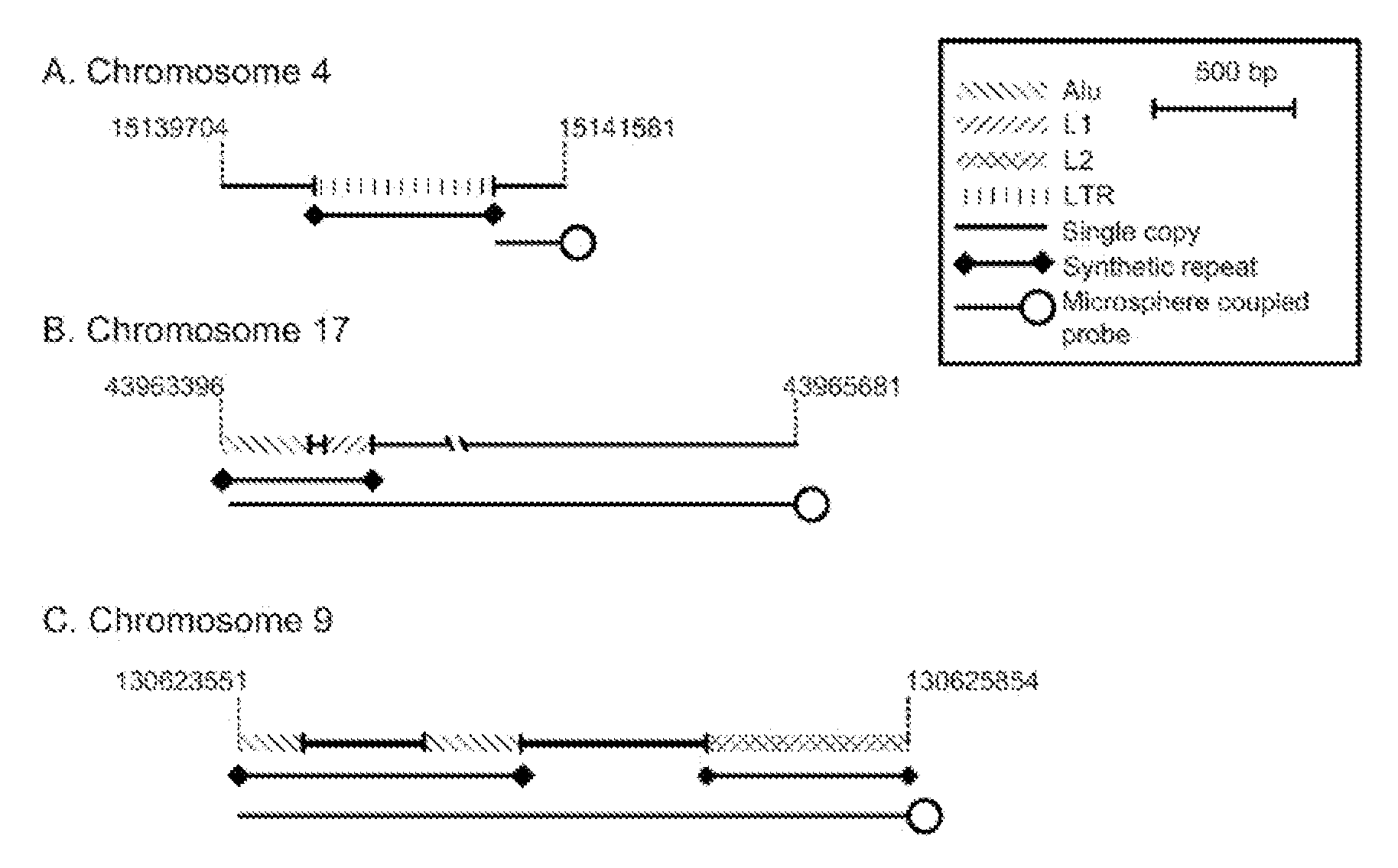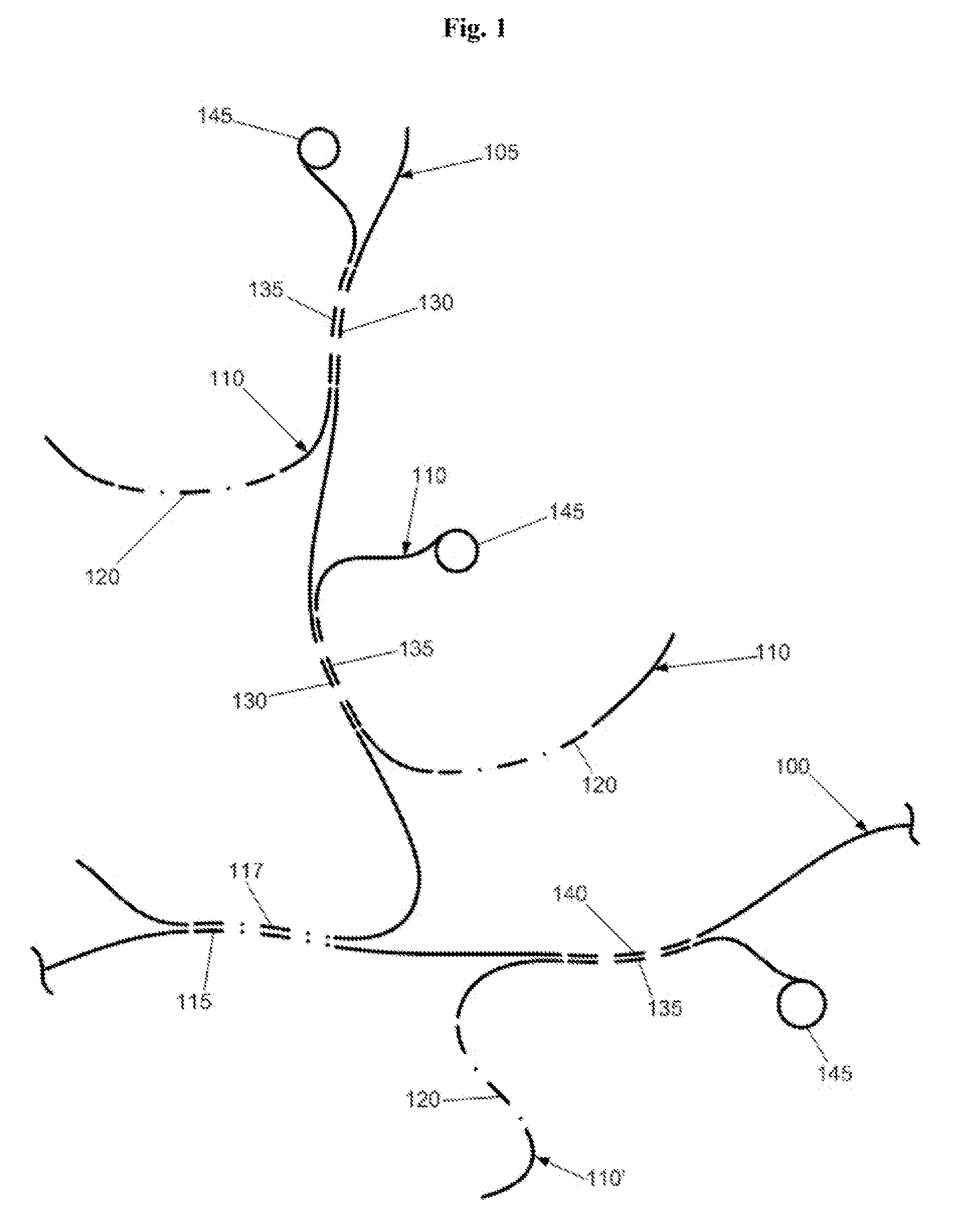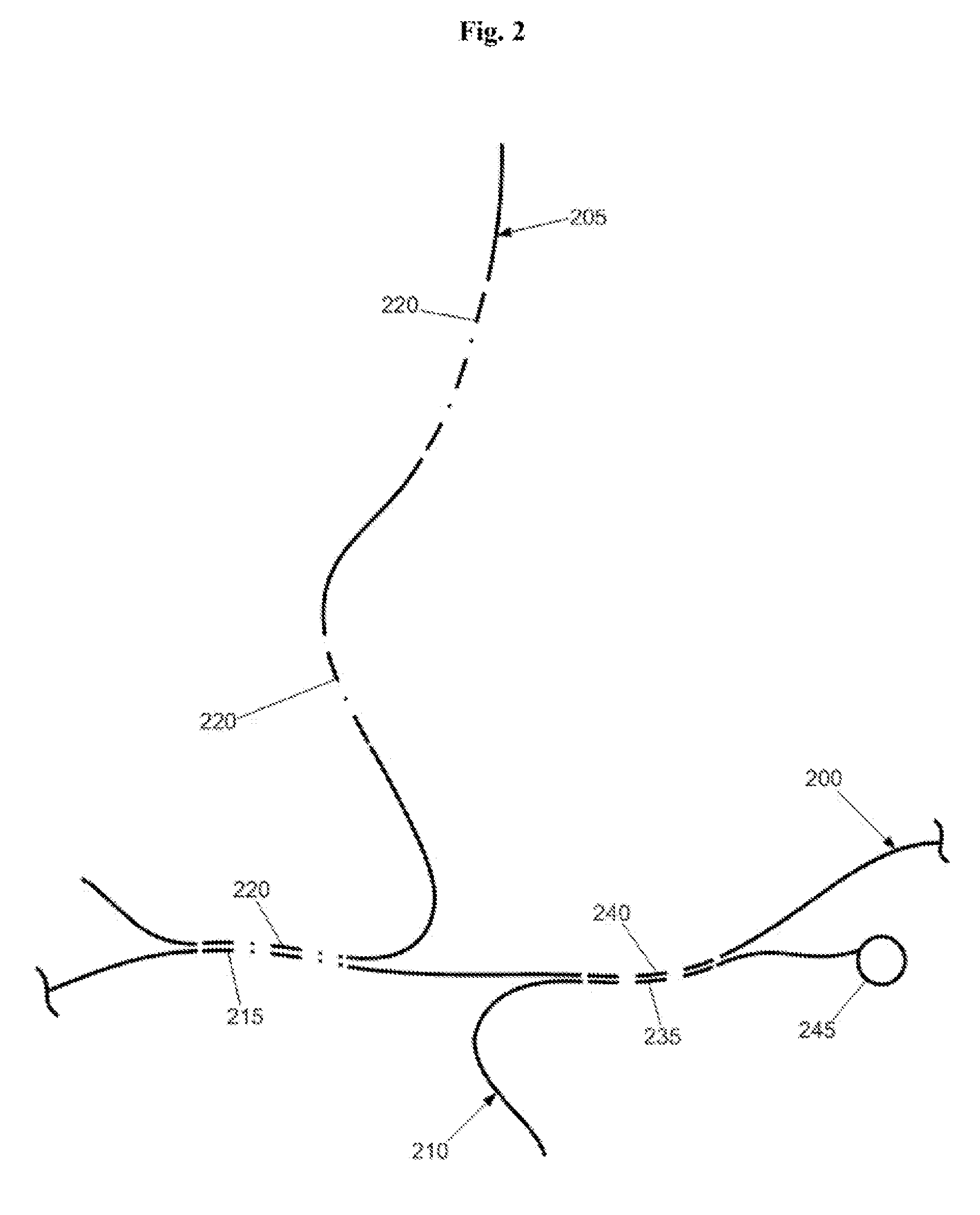[0016] The present invention overcomes the problems outlined above and provides novel methods and products for suppressing the result-distorting effect of C0t-1 DNA through replacement of C0t-1 with suppressive nucleic acids synthesized to be rich in repeat elements but substantially devoid of single or low copy elements. Generally speaking, the method of the present invention includes the steps of preparing synthetic suppression DNA, and hybridizing the suppression DNA to target
genomic DNA in order to block
repetitive sequences in the target prior to hybridizing a probe with the target. Preferably, the probe will be free or substantially free of repetitive elements and the suppression DNA will be free or substantially free of single or low copy DNA stretches. In some preferred forms, the method will include the steps of preparing a
hybridization probe by
coupling a spectrally-encoded,
polystyrene microsphere to a selected, low copy,
synthetic DNA sequence; pre-hybridizing target
genomic DNA with synthetic, suppressive or blocking DNA of the present invention; hybridizing the probe to the target
genomic DNA, and detecting the product of the hybridization by
flow cytometry. The demonstrated
signal distortion caused by C0t-1 in hybridization assays was thereby mitigated by suppressing cross-hybridization through pre-hybridization of the target to synthetic repetitive elements that are free or substantially free of single copy sequences, and preferably free or substantially free of low copy sequences.
[0019]FIG. 2 illustrates hybridization of synthetic, suppressive DNA 205 to a genomic DNA target 200 to suppress or block a
repetitive element 215 in the target. As shown, the synthetic, suppressive DNA 205 does not present adventitious single or low copy elements that would hybridize with single or low copy elements 235 in the probe 210 or single or low copy elements 240 in the target 200, thereby significantly reducing cross-hybridization of single or low copy elements in the
assay. The probe 210 is preferably synthesized to comprise one or more single or low copy elements 235 but is devoid of repetitive elements that might otherwise hybridize to homologous repeats in the suppressive DNA 205 or target 200. In the FIG. 2, the
probe signal would have a direct 1:1 correspondence with the single or low copy element 240 in the target 200.
[0022] Another aspect of the present invention provides a novel method of increasing hybridization specificity between
low copy number nucleic acid probes and homologous regions in a target nucleic acid. Generally, such a method includes the steps of hybridizing repetitive elements in the target nucleic acid with homologous repetitive elements in a suppressive nucleic acid, wherein the suppressive nucleic acid comprises a plurality of repetitive elements and is synthesized or selected to be substantially, and more preferably, completely devoid of
low copy number elements, and hybridizing
low copy number elements in the target nucleic acid with homologous low copy number elements in one or more of the
nucleic acid probes. In preferred forms, the repetitive elements in the suppressive nucleic acid are selected for having substantial homology to repetitive elements flanking low copy elements in one or more representative genomic regions. Even more preferably, the flanking repetitive elements are of moderate to high copy number and the low copy elements comprise single copy elements. Still more preferably, the probes are substantially devoid of repetitive elements.
[0023] Another aspect of the present invention provides a method for accurately quantitating
nucleic acid sequence copy numbers. Generally, such a method comprising the steps of preparing a first, spectrally-encoded, fluorescent
microsphere having a first spectral address, and a second, spectrally-encoded, fluorescent
microsphere having a second spectral address, identifying a target genomic nucleic acid probe sequence by ascertaining the
nucleotide-by-
nucleotide sequence of a target
nucleic acid sequence wherein the sequence of interest is suspected to reside, synthesizing a low copy target probe derived from the identified target genomic nucleic acid probe sequence, the target probe comprising at least one low copy element and being substantially devoid of repetitive elements, conjugating the target probe to the first microsphere, synthesizing a reference probe selected to hybridize to a reference
nucleic acid sequence of the target nucleic acid sequence, conjugating the reference probe to a microsphere having a second spectral address, identifying
repetitive sequences in a representative genomic region, synthesizing suppressive nucleic acid, the suppressive nucleic acid comprising sequences of sufficient homology to hybridize to the identified
repetitive sequences, the suppressive nucleic acid substantially comprising repetitive elements and being substantially devoid of low copy elements, reacting the suppressive nucleic acid with a chromosomal target sequence, thereby causing repetitive elements in the suppressive nucleic acid to hybridize with homologous repetitive elements in the chromosomal target sequence, reacting the target probe to the chromosomal target sequence thereby causing low copy elements in the target probe to hybridize to homologous low copy elements in the chromosomal target sequence, reacting the suppressive nucleic acid with a chromosomal reference sequence containing the chromosomal target sequence thereby causing repetitive elements in the suppressive nucleic acid to hybridize to homologous repetitive elements in the chromosomal reference sequence, reacting the reference probe with the chromosomal reference sequence thereby causing the reference probe to hybridize to the chromosomal reference sequence, detecting the hybridized target probe via the first spectral address, detecting the hybridized reference probe via the second spectral address, and quantifying the detected target probe by comparing the response of the detected hybridized target probe with the response of the detected hybridized reference probe. In preferred forms, the suppressive DNA comprises repetitive elements with the repetitive elements corresponding to genomic repetitive elements adjacent to low copy elements in the target.
[0025] In another aspect of the present invention, a method of suppressing non-specific cross-hybridization between low copy elements present in suppressive nucleic acid and homologous low copy elements in
nucleic acid probes or target nucleic acid is provided. Generally, the method comprises the steps of identifying repetitive and low copy elements within and near the target nucleic acid, synthesizing suppressive nucleic acid sequences by selecting repetitive sequences from the target nucleic acid for inclusion in the suppressive nucleic acid while substantially avoiding the inclusion of low copy sequences in the synthesis process, and reacting the synthesized suppressive nucleic acid with the target nucleic acid such that the respective homologous suppressive nucleic acid and target nucleic acid elements hybridize with each other.
[0026] The present invention also provides a method of increasing the accuracy and reproducibility of assays using suppressive or blocking DNA (e.g. Cot-1 DNA) comprising the steps of selecting or synthesizing suppression nucleic acid that includes a plurality of repetitive elements but is substantially free of low copy sequences and using or substituting the selected or synthesized suppression nucleic acid in place of Cot-1 DNA.
 Login to View More
Login to View More 


